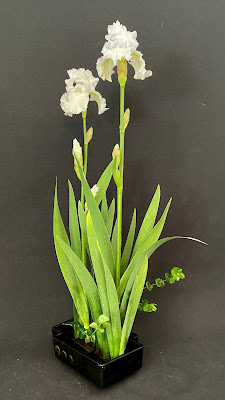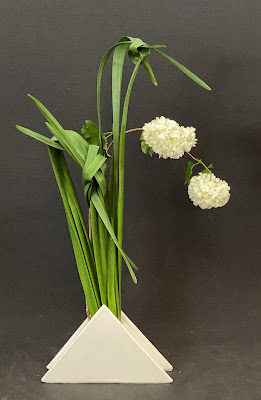Hello all,
Above is a quintessential spring arrangement with flowering crab apple branches and flag iris flowers. Ordinarily, I use the flag iris in traditional arrangements using the full stem of the flower as well as a large number of leaves. Below is an example of that style. However, I have a greater number of flowers that other years, thanks to my student Nicole, who brought a whole lot of rhizomes to share with the class two years ago. Therefore, I can afford to cut the top flower of each stem because that's the one that opens first and use it as an individual flower.
 |
| Front view |
 |
| Side view |
Very often, after finishing an arrangement and placing it in its designated spot, I will look at it and find fault and will need to correct it. Other times, one or more of the materials may die whilst the rest of the arrangement is still viable and I will, simply, have to replace the dead materials. Below are some examples of this.
I made a slight change to the wall arrangement, below but I was happier with the corrected version.
 |
| Before - lilac and nandina domestica flower buds |
 |
| After - Lilac and nandina domestica flower buds and leaves |
I made the arrangement, below, because I wanted to use the few flowers that my wisteria produced and the last of the rhododendron.
Unfortunately, the rhododendron flowers died after two days and I replaced them with clematis. I had to re-work the arrangement a little bit but I was happy with the result.
After photographing it and moving away from it, I came back and it struck me that the lines I wanted to emphasize were not so clear. By removing the central branch, the lines became clearer.
Out in the garden I was admiring the length of the jonquil leaves, some of which are more than 70cm tall, and wanted to use them in some way. I also had an anthurium in my indoor plant that I've been looking for an opportunity to use. The two materials came together quite well. That is until later, when I decided that the flower was a bit too small for the size of the leaf structure and looked around for other material with which to replace it. I settled on the viburnum opulus.
 |
| Before |
 |
| After |
And while we're on the subject of viburnum opulus, I like some of the interesting shapes of the stems of this small tree.
Emily






No comments:
Post a Comment